


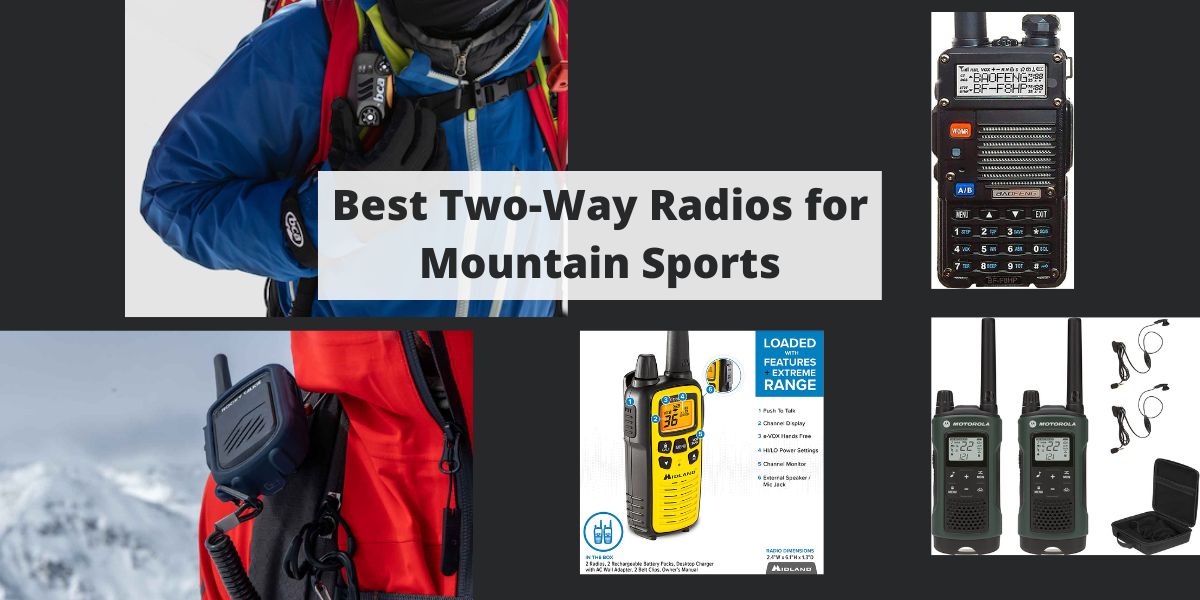
When you’re in the mountains skiing, hiking, or doing any other mountain sports, you need a way to communicate with the rest of your party that’s fast and reliable. This rules out cell phones, which require dialing (not always easy in an emergency) and may not have reception. Your best bet for mountain sports is a two-way radio. Today, we’re going to talk about the key features of a two-way radio and share some of the best two-way radios for mountains and other outdoor areas.
There are several kinds of two-way radios out there, including large car-mounted units– which are not the ones we are talking about today. The two-way radios you use outdoors are small, handheld units that may have a base station that stays at camp. Some radios have a body you can toss in your backpack and a mic, handpiece, or headset that stays on your body.
Two-way radios are an important part of mountain sport safety, because they can ensure that you get back to your friends if you get separated. They can keep you alert to sudden weather changes, and if the worst happens, they can help coordinate disaster relief efforts.
Two-way radios broadcast on a number of channels and at a number of different powers. It’s important to understand these because it makes a difference about how you can use the two-way radio. Some do actually require licensing to use!
Most two-way radios commonly available require no license to use.
That being said, some two-way radios require a license to operate; it depends on whether they broadcast on either FRS or GMRS radio frequencies. FRS frequencies, or Family Radio Service frequencies, are free to use and require no license. GMRS frequencies that use low power are free to use.
But if you use high-powered (5 W or more) GMRS frequencies, you do need a license from the FCC, which is $35 per ten-year term and covers your use and your family’s use. This does include handheld radios used for hiking and other recreational activities. Midland Radio has a great guide to filing for this license online, and we will note in our recommendations whether each radio requires a license to use or not.
It isn’t uncommon to see people refer to two-way radios as walkie talkies, and vice versa. But the two are different, and when you’re up in the mountains, you want to make sure you have the right one.
| Walkie Talkies | Two-Way Radio | |
| Range | Relatively short range | Range of up to 25+ miles |
| Frequencies | 1 Frequency | Multiple frequencies/channels |
| Durability | Lightweight and not very durable; often marketed as children’s toys | More durable, frequently shock, drop, and water resistant |
| Audio Quality | Poor | Better |
| Portability | Lightweight and small | Can be heavier, but often still sized for easy portability |
| Additional Features | Unlikely to have extra features | May include secure channels, audio enhancements like white noise squelching, voice refining, and extra security and product safety features |
With that in mind, there are some similarities. Both walkie talkies and two-way radios use push-to-talk technology, although a two-way radio is more versatile and can handle a wider range of frequencies. Both are frequently used outdoors, and while a walkie talkie might be fine for beginners or hiking where you aren’t planning on getting too far away from each other, they aren’t ideal for mountain sports.
However, since the terms are used so interchangeably, you should make your choice based on features rather than what the two-way radio is marketed as.
When shopping for the best two-way radios for hiking, skiing, and other mountain sports, you have a lot of elements to consider. Here are the key things to look for when shopping for two-way radios.
Mountain sports can be tough on gear, so it’s essential to choose a two-way radio that is durable and can withstand the elements. Look for a radio that is waterproof, shock-resistant, and designed for outdoor use. If your outdoor activities include anything near water, like fishing or boating, consider a two-way radio with a safety leash, or add a lanyard. Or buy a devices that floats.
Make sure to choose a two-way radio with a battery that will last for the duration of your activity. Consider carrying spare batteries or a charger to ensure that you can stay connected when you need to.
You also need to know the coldest temperatures that the batteries can operate at. Extremely cold weather conditions can sharply decrease battery life, so unless you want to carry around a pocketful of batteries, you need to make sure that your radio can operate at mountain temperatures.
The range of a two-way radio is one of the most important factors to consider, as it determines how far you can communicate with other radios. Look for a radio with a range that meets your needs based on the terrain and distance you will be covering. Keep in mind that the terrain can cause interference, so look for a powerful radio that can transmit and receive potentially at a greater distance than you think you may need.
Look for radios with reviews and/or third party testing in real life scenarios for accurate range. The ranges marketed for most radios is generally just based off of no obstructions in clear line of site, which is a rarity for many scenarios.
If you plan to use your two-way radio for mountain sports like skiing, biking, climbing, or anything else where you need your hands, making sure the device is extremely easy to use is key. Most two-way radios have very easy buttons to speak, and change settings.
Some radios have Voice Operated Transmission (or VOX) setting, which is a feature to consider. This feature means that the radio is sensitive to the sound of your voice and will transmit for you without having to push a button whenever you speak.
Some two-way radios even come with a headset you can use to ensure that your hands-free communication comes through clearly.
One of the reasons you might accidentally buy a two-way radio that isn’t designed for mountain sports is the size and weight. There’s a real tradeoff between portability and durability, and many of the best two-way radios are a little on the bulky side. You want a two-way radio that is lightweight and portable, but you don’t want a two-way radio that isn’t made with durable enough materials to withstand heavy impact.
Two-way radios can have lots of useful bonus features, including built-in flashlights, NOAA weather alerts, and more. While these features may increase the cost of the radio, some of them really are invaluable in an emergency. Weather alerts in particular can be really useful; if you’re off backcountry skiing or hiking, knowing about any sudden changes in the weather can make a huge difference to your safety.
Ready to pick out a new two-way radio? All of these picks are great options. The chart below gives you an at-a-glance look comparing the two-way radios we feature based on some of the key traits, and we give you a more detailed look at each product further down.
| Rocky Talkie | BC Link 2.0 | Motorola T600 | Motorola T465 | Midland LXT630VP3 | Midland GXT1000VP4 | BaoFeng BF-F8HP | |
|---|---|---|---|---|---|---|---|
| Max Range | 25 miles | 40 miles | 35 miles | 35 miles | 30 miles | 36 miles | Unknown but immense |
| Max Battery Life | 5 days | 400 hours | 23 hours (AAs)/9 recharge | 23 hours (AAs)/8.5 recharge | 6 hours | 11 hours | 24 hours |
| License Needed | No | No | No | No | No | Yes | Yes |
| Min. Price | $110 | $164 | $97 for two radios | $90 for two radios | $60 for two radios | $40 | $69.89 |
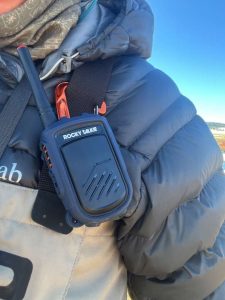
Rocky Talkie strapped to waders while fly fishing in Colorado
The Rocky Talkie is one of the best two-way radios for skiing, hiking, climbing, and any other mountain sport. It’s a durable radio with an incredible range and an attachment system designed to keep the radio safely attached to your person at all times. It has lots of bonus features, like a privacy mode, scan mode, and channel lock. We’ve actually reviewed this little radio in great detail, and we have to say: we love it. This is an awesome piece of gear for mountain adventurers.
Most importantly, the battery life on this device is incredible.
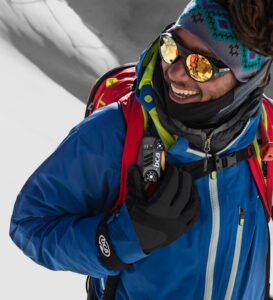 This is one of the best two-way radios for skiing, and is designed with snow sport features in mind. This includes snow resistance, a snowproof mic, and integration into Stash bags and Float avalanche airbags. It’s easy to stash the radio in your backpack and clip the mic to your shoulder strap for easy communication. Its performance is incredible, and it has extremely good battery life at cold temperatures.
This is one of the best two-way radios for skiing, and is designed with snow sport features in mind. This includes snow resistance, a snowproof mic, and integration into Stash bags and Float avalanche airbags. It’s easy to stash the radio in your backpack and clip the mic to your shoulder strap for easy communication. Its performance is incredible, and it has extremely good battery life at cold temperatures.
 This neon yellow (or is it green?) radio stands out, so you won’t lose it in the dark. Or in the water, because this two-way radio actually floats! It’s fully waterproof and extremely rugged and durable. The battery life is a little low, but it recharges with micro USB so you can plug it into your favorite power bank, or just pop in new AA batteries. The clip on this model isn’t as durable as the rest of the radio, so do pay attention to that– you may want to attach a tougher carabiner.
This neon yellow (or is it green?) radio stands out, so you won’t lose it in the dark. Or in the water, because this two-way radio actually floats! It’s fully waterproof and extremely rugged and durable. The battery life is a little low, but it recharges with micro USB so you can plug it into your favorite power bank, or just pop in new AA batteries. The clip on this model isn’t as durable as the rest of the radio, so do pay attention to that– you may want to attach a tougher carabiner.
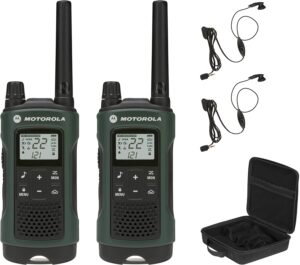
The Motorola T465 is another popular Motorola offering that works great in the mountains. They’re weatherproof, although a little less robust than the Motorola T600, and also feature a built-in flashlight. These are excellent for situations that require quiet, thanks to their vibracall feature, which works just like the vibrate mode on your phone.
These come with headphones and microphones for communication and lots of other hunting related features.
They have a VOX setting as well, meaning you can use them hands-free. They offer great sound clarity, too. The hands-free and quiet settings make them a particularly good option for climbing.
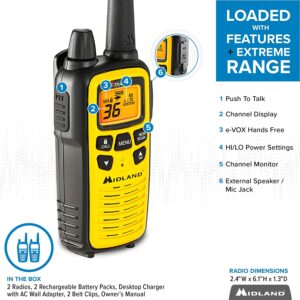 This offering from Midland is a durable, compact little device that gives you a lot of bang for your buck. Another good choice for climbers, their VOX hands-free setting and light weight makes them easy to clip onto your belt or shoulder strap and not think about too much as you ascend. They have a silent mode that turns off all alert tones, and they are compatible with AAA batteries if you’re concerned about that short battery life. They’re sold as a pair with a base station for charging.
This offering from Midland is a durable, compact little device that gives you a lot of bang for your buck. Another good choice for climbers, their VOX hands-free setting and light weight makes them easy to clip onto your belt or shoulder strap and not think about too much as you ascend. They have a silent mode that turns off all alert tones, and they are compatible with AAA batteries if you’re concerned about that short battery life. They’re sold as a pair with a base station for charging.
This pair stands due to the warranty and low price, but we don’t like the short battery life for cold environments or long trips.
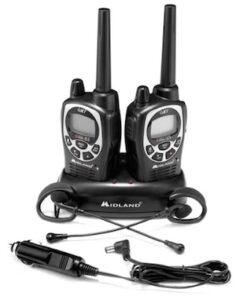 The Midland GXT1000VP4 model was designed with hunting in mind, which makes it excellent for the mountains– a lot of the hunting features, like silent calling, a microphone that can pick up whispers, call alerts to warn your party before you speak, VOX mode, and audio squelching are really useful in the mountains. With access to 50 GMRS channels (and the ability to communicate with radios on the FRS channels, too), as well as the ability to scan and check on two channels at once, this radio is ideal for coordinating communications.
The Midland GXT1000VP4 model was designed with hunting in mind, which makes it excellent for the mountains– a lot of the hunting features, like silent calling, a microphone that can pick up whispers, call alerts to warn your party before you speak, VOX mode, and audio squelching are really useful in the mountains. With access to 50 GMRS channels (and the ability to communicate with radios on the FRS channels, too), as well as the ability to scan and check on two channels at once, this radio is ideal for coordinating communications.
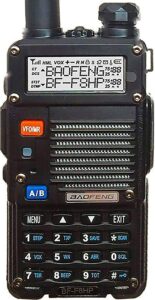 If you want range, the BaoFeng BF-F8HP is the two-way radio you need. They don’t list the sunny day, line of sight range, but tests have demonstrated that you can broadcast in terrible weather with tons of interference and still have perfectly crystal-clear transmissions. If you’re in need of a portable radio with large range, this radio might be perfect for you.
If you want range, the BaoFeng BF-F8HP is the two-way radio you need. They don’t list the sunny day, line of sight range, but tests have demonstrated that you can broadcast in terrible weather with tons of interference and still have perfectly crystal-clear transmissions. If you’re in need of a portable radio with large range, this radio might be perfect for you.
However, there is one major downside to this beefy radio: it requires a ham radio license to use. This is not a difficult or expensive license to get, but you will need to apply for one online at the FCC’s website if you want to use all of the capabilities of this two-way radio. If you’re ok using the GMRS channels, then you will only need that license. But if there’s a chance you’ll switch into the higher watt settings (anything above 4 watts), then you should get the ham radio operator license.

